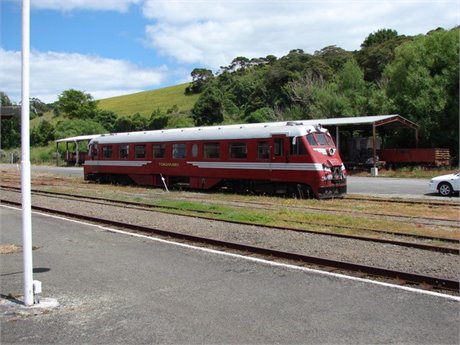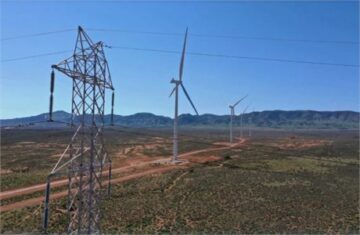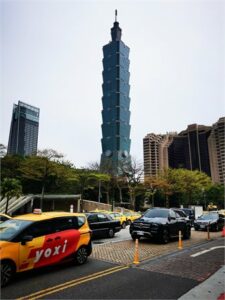To call the company’s plans ambitious is an understatement. The aim is to have New Zealand-designed and built battery-powered railcars plying some of the 3500km of track that connects most of the country’s towns and cities within five to seven years.
A railcar is a self-propelled railway vehicle usually made up of one or two carriages. They're not new to New Zealand. From 1936 to 1978 Aotearoa had a national passenger network operating from Opua in the North Island to Invercargill in the South, using a fleet of bidirectional diesel powered railcars.

Wenlock likes electric vehicles. He put a golf cart engine into a Honda City and achieved a top speed of 10km/h, and is currently converting an Audi TT to electricity with the aim of using it as a runabout… top speed 50m/h.
It would be easy to dismiss him as yet another Kiwi backyard tinkerer with big dreams and a garage full of abandoned projects.
But he’s got form when it comes to setting up successful companies. Wipster – a video collaboration platform, which he founded in 2012 – is still going strong with corporates clients including the likes of Microsoft and Disney.
And he plans to leave the mechanical and electrical engineering, manufacturing and data crunching to the other four founders who have expertise in those areas.
Keeping it local
A hackneyed criticism of New Zealand entrepreneurs is that their vision doesn’t extend beyond the BMW, the boat and the bach.
That’s not an accusation that can be levelled at Wenlock. In 2018 he moved to the US to be closer to Wipster’s customer base.
In 2020 covid saw him and his young family return to New Zealand. He remains on Wipter’s board but is no longer an employee.

He says he spent the last 10 years getting Wipster to where is now and plans to spend the next 20 on the Miro railcar project.
Wenlock is determined to have the railcars designed and built in New Zealand.
“It's very important to me to make this a 100% New Zealand story.”
Solving a specifically New Zealand problem
He says for Wipster, and many other companies, it makes sense to go global and be close to bigger markets but the railcar project is about solving a specifically New Zealand problem.
A relatively large, long country with a tiny population scattered from one end to the other with an existing network of narrow gauge track.
“It's very, very rare for a country to have this type of opportunity. And it means that what you have to produce has to be really specific to solve the problem which is why you won't be able to see our design anywhere else in the world.”
He says New Zealand already manufacturers buses, fire engines and electric ferries and there’s no reason why it shouldn’t manufacture railcars too.
Yes, China, might be able to build them cheaper but by manufacturing them here, you’re not only keeping the money in New Zealand, you’re training a workforce who will then go to develop other technologies, Wenlock says.
“We can raise the money we need here. The engineering skills are here. The manufacturing capability is here. And all of our customer are here.”

Miro takes its name not from the Catalan artist but the native tree, which Wenlock maintains, has a leaf that resembles a railcar. You be the judge.
Wenlock says battery-powered railcars just make sense in New Zealand. They emit about six grammes of carbon per passenger, per kilometre compared to the 250 grammes emitted by an ICE car.
It’s a very energy efficient way to move people around because there’s a lot less friction, he says. So it’s not just superior to ICE cars, it’s significantly more efficient than EVs or even electric buses.
Wenlock says the availability of quick, affordable rail transport will change the profile of who’s travelling.
While many see higher density cities as the likely outcome of adapting to climate change, Wenlock, believes a relatively quick and comfortable railcar service would see people moving to provincial towns with a mix of tele-commuting and railcar rides connecting them to their city jobs.
“I think there'll be a big shift in how people live in all the spaces in between. So being able to go from Dunedin to Christchurch would be great, but being able to go from Timaru to Christchurch might be even better.”
He says the speed and convenience of the railcars will allow people to commute from provincial towns to other towns or cities that are currently out of reach of an easy car commute.
“You’d be having these little rail cars zipping between every major centre multiple times a day. You’d be going from Wellington up to the East Coast. You’d be going to Hawke’s Bay. You’d be going to Auckland. And then from Auckland you can go to Northland. And in the South Island you’ll be able to go from Picton to Invercargill.”
Speeds of up to 300km/h possible
Miro plans to test its rail cars up to 300km/h but, initially at least, Wenlock says, they will be limited by the current KiwiRail limit of 110km/h.
He says he believes in time the railcars could be able to safely reach speeds of 200km/h.
But, he says, the average speed is what really matters. The ability to rapidly accelerate and deaccelerate will mean the railcars can complete journeys significantly quicker than cars and typically see passengers disembarking in the middle of town.
Initial calculations show a trip between Christchurch and Dunedin will take three hours.
The plan is to offer the railcars on a subscription model to public transport providers with Miro carrying out all the maintenance.
He contrasts that with KiwiRail’s recent half billion dollar purchase of 57 diesel locomotives from offshore which are being serviced by an international company.
“So all of that money is going offshore, never to be seen again. Why not have all that money stay onshore to be seen again and again and again.”
Miro aims to have its first prototype built within 18-months and a production ready railcar on the tracks within five to seven years.
Wenlock says he's extremely confident that local investors will be found to back the project.
In the future the company could go public giving New Zealanders the chance to take stake in the company but
Wenlock foresees a time when it might make sense for the government to take a controlling stake in the firm.
He says Miro Rail is about enabling New Zealanders to travel in a more efficient and sustainable way and it has more chance of doing that over the next 100 years if the government is involved further down the track.
Wenlock says his role in the company is making things happen, so the business can achieve its goal of bringing back regional rail.
At this stage the company hasn't approached anyone in central government but has had initial talks with regional councils.
He says there's no point talking to the government until the project is further down the track, but he had discussions with represenatives from regional councils who have been very positive about the idea.
If Miro is successful it won’t be the first electric railcar in New Zealand. In the 1920s NZ Rail ran a battery electric railcar between Christchurch and Little River.
In a weird coincidence Wenlock grew up in Little River but didn’t hear about the country’s first battery railcar until fairly recently.
The Edison was built in 1926 and was destroyed in a charging fire eight years later.
(First published 1 September 2022.)
.
.
- SEO Powered Content & PR Distribution. Get Amplified Today.
- Platoblockchain. Web3 Metaverse Intelligence. Knowledge Amplified. Access Here.
- Source: https://www.carbonnews.co.nz/story.asp?storyID=25806
- 1
- 10
- 100
- 2012
- 2018
- 2020
- 2022
- a
- ability
- Able
- About
- accelerate
- Achieve
- achieved
- affordable
- aims
- All
- already
- ambitious
- and
- Another
- anyone
- anywhere
- areas
- around
- artist
- audi
- availability
- average
- back
- base
- battery
- Bay
- because
- being
- believes
- Better
- between
- Beyond
- Big
- bigger
- Billion
- BMW
- board
- boat
- Bringing
- build
- built
- business
- call
- car
- carbon
- carrying
- cars
- central
- centre
- Chance
- change
- charging
- cheaper
- China
- Cities
- City
- clients
- Climate
- Climate change
- Close
- closer
- Coast
- coincidence
- collaboration
- comfortable
- Companies
- company
- Company’s
- compared
- complete
- confident
- Connecting
- connects
- controlling
- convenience
- corporates
- could
- country
- country’s
- Covid
- criticism
- Current
- Currently
- customer
- Cut
- data
- day
- designed
- destroyed
- determined
- develop
- discussions
- Dismiss
- Disney
- Doesn’t
- doing
- Dollar
- down
- dreams
- East
- Edison
- efficient
- Electric
- electric vehicles
- electricity
- Emissions
- Employee
- enabling
- energy
- Engine
- Engineering
- Engines
- entrepreneurs
- Even
- existing
- expertise
- extend
- extremely
- fairly
- family
- Fire
- Firm
- First
- FLEET
- form
- found
- Founded
- founders
- friction
- from
- full
- further
- future
- garage
- getting
- Giving
- Global
- Go
- goal
- going
- golf
- Government
- great
- Half
- happen
- having
- here
- higher
- HOURS
- How
- HTTPS
- ICE
- idea
- important
- in
- Including
- initial
- initially
- International
- Investors
- involved
- island
- IT
- Jobs
- Journeys
- judge
- keeping
- large
- Last
- Leave
- likely
- LIMIT
- Limited
- little
- live
- local
- Long
- longer
- Lot
- made
- maintains
- maintenance
- major
- make
- MAKES
- Making
- Manufacturers
- manufacturing
- many
- Markets
- Matters
- means
- mechanical
- Microsoft
- Middle
- might
- model
- money
- more
- more efficient
- most
- move
- moving
- multiple
- name
- National
- native
- Need
- network
- New
- New Zealand
- next
- North
- offer
- ONE
- operating
- Opportunity
- Other
- People
- plan
- plans
- platform
- plato
- Plato Data Intelligence
- PlatoData
- Point
- population
- positive
- powered
- Problem
- produce
- Production
- Profile
- project
- projects
- promises
- prototype
- providers
- Provincial
- public
- published
- purchase
- put
- Quick
- quicker
- Rail
- Railway
- raise
- rapidly
- RARE
- RE
- reach
- ready
- reason
- recent
- recently
- regional
- relatively
- remains
- resembles
- return
- River
- Role
- safely
- scattered
- sense
- September
- service
- setting
- seven
- shift
- show
- significantly
- SIX
- skills
- So
- SOLVE
- Solving
- some
- South
- spaces
- specific
- specifically
- speed
- speeds
- spend
- spent
- Stage
- stake
- Start-up
- stay
- Still
- Story
- strong
- subscription
- Subscription model
- successful
- superior
- sustainable
- Take
- takes
- talking
- Talks
- Technologies
- test
- The
- the world
- their
- things
- three
- time
- times
- to
- too
- top
- towns
- track
- Training
- transport
- travel
- trip
- typically
- us
- usually
- vehicle
- Vehicles
- vision
- What
- which
- WHO
- will
- within
- Won
- Workforce
- world
- would
- years
- young
- Zealand
- zephyrnet












